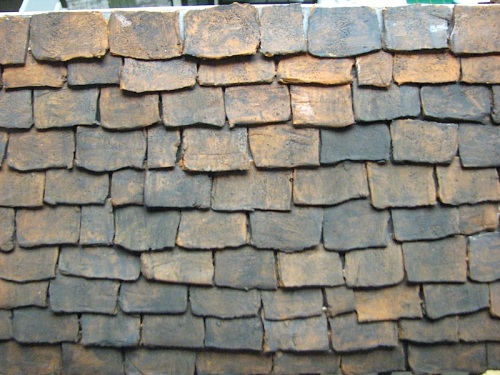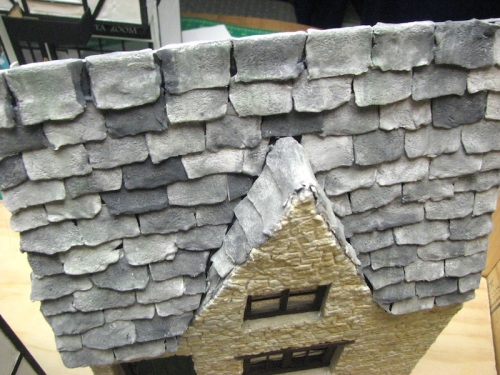All of the structures needed some sort of roof. There are various products on the market for roofing material from plastic sheets depicting shingles to individual wood shingles. None of these really were what I wanted. Aside from the iconic thatched roof which I didn’t want to get into, many of the older buildings in England had either tile or slate roofs. After reading an article in Dollhouse Miniatures by Rik Pierce on using Paperclay for shingles, I decided to give it a try. I rolled out my Paperclay using some tools that I got at a Rik Pierce course I took in 2008. Basically it is a 1 1/2” diameter solid plastic dowel (my rolling pin) and a linoleum tile set in a wooden frame. The tile is 1/16” below the surface of the frame, so when you have rolled the Paperclay out it will be at a uniform thickness of 1/16”. I should say this is just one of the many things one learns when taking a course with Rik, a teacher par excellence.
After experimenting I finally settled on cutting out each individual shingle and the then taking a shaping tool and flattening the tile to thinner than a 1/16”. On the left side of the picture you can see a couple of these tiles, and the tile no longer has the perfect rectangular shape of the cut out piece. After all the shingles are cut out I take a very stiff bristled brush and repeatedly press it down on each shingle to give it some texture. The shingles are allowed to dry overnight.
The next day, before I glue them to the gator foam roof, I paint the shingles. I also paint the gator foam roof black so that any little gaps between shingles won’t show up as white. For the Cotswold cottage, which in real life had a slate roof, I painted the shingles varying shades of charcoal (you can just vary the intensity of the color by diluting the acrylic paint with water). The pub roof has clay tiles so I first painted all the shingles with terra cotta. After letting them dry, I came back and painted over them with black and dark burnt umber. What I wanted in the end is a basically dark roof with a hint of the underlying clay. After the shingles, or I should say tiles, are painted I glue them to the roof starting with the bottom row and then slightly overlapping each successive row. Also one needs to stagger the register of each row. Now that a roof is over our heads we can go inside and start working on interiors.




These look great!
LikeLike